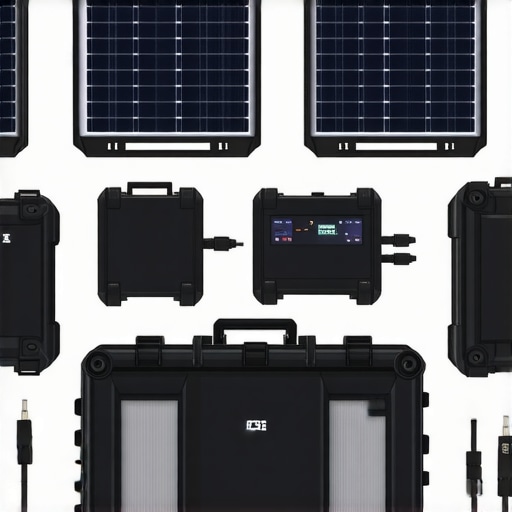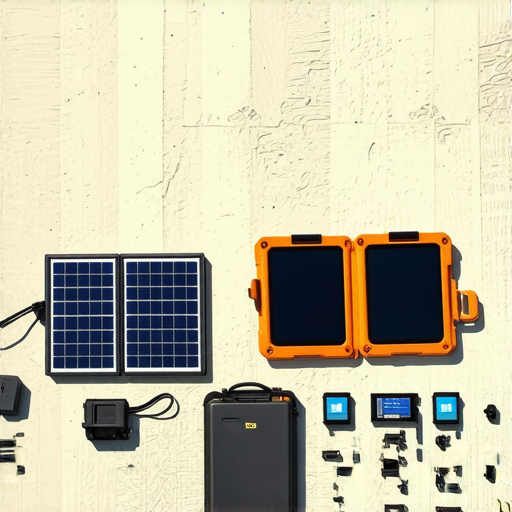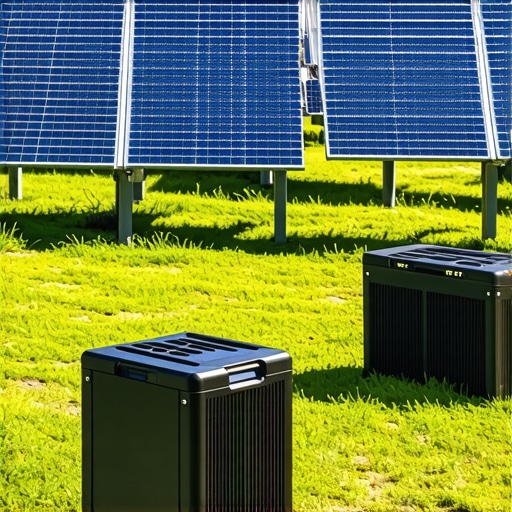My Personal Journey into Portable Solar Power
Ever since I took my first camping trip into the wilderness, I realized how crucial reliable power sources are when you’re off the grid. I vividly remember struggling to keep my devices charged while surrounded by nature, which sparked my curiosity about portable solar panels and solar generators. Over the years, I’ve experimented with various models, and by 2025, I feel confident sharing my insights on the best options available today.
Why I Chose Portable Solar Panels and Generators for My Adventures
Living sustainably and embracing renewable energy has become a personal passion. I wanted equipment that was not only efficient but also lightweight and easy to carry. After extensive research and personal testing, I found that the top portable solar panels and solar generators truly make a difference, especially when exploring remote locations or during emergency situations. As noted by experts at Energy.gov, solar power is a clean energy solution that can significantly reduce our carbon footprint.
My Experience with the Leading Portable Solar Power Kits
One standout in my collection has been the best portable solar panels of 2025. These panels are remarkably efficient, fold down into compact sizes, and are protected against weather conditions. Paired with a portable solar generator, such as those featured in top solar generators for 2025, I was able to power my small appliances, charge phones, and even run lights long into the night.
What Makes a Solar Generator Truly Portable?
One question I often get is, “What makes a solar generator portable enough for my needs?” In my experience, portability is about weight, size, and ease of setup. The best models I found strike a good balance between power capacity and portability, making them ideal for camping, RVing, or emergency preparedness. For those interested in off-grid living, exploring options like off-grid solar power kits can be a game-changer.
How Do I Maximize Solar Efficiency During My Trips?
Maximizing efficiency involves positioning your panels correctly and choosing models with high conversion rates. I always aim to angle my panels toward the sun during peak hours, which is typically around midday. Additionally, keeping panels clean and free of debris ensures optimal performance, as highlighted by solar efficiency experts. For detailed tips and the latest gear reviews, I highly recommend visiting the ultimate guide to solar power kits for 2025.
If you’re considering upgrading your off-grid power setup, I encourage you to explore the comprehensive range of options available. Whether for recreational use or emergency preparedness, the right portable solar equipment can transform your outdoor experiences and provide peace of mind. Feel free to share your own experiences or ask questions in the comments section—I love exchanging ideas with fellow solar enthusiasts!
Innovative Strategies to Boost Solar Power Efficiency on Your Off-Grid Journeys
As a seasoned enthusiast in portable solar solutions, I often get asked about optimizing the performance of solar panels and generators in diverse environments. While selecting high-quality equipment is crucial, understanding the nuanced techniques to enhance efficiency can make a significant difference during extended off-grid adventures. From proper panel positioning to environmental considerations, mastering these strategies ensures you get the most out of your solar setup.
What Are the Subtle Factors That Influence Solar Panel Output?
Beyond the obvious aspects like panel quality and sunlight availability, factors such as temperature, shading, and panel cleanliness play vital roles. For instance, high temperatures can reduce a solar panel’s efficiency, so installing panels in well-ventilated areas or using cooling techniques can be beneficial. Additionally, even minor shading from nearby objects can drastically decrease power output, emphasizing the importance of strategic placement. Regularly inspecting and cleaning panels to remove dust, leaves, or snow ensures they operate at peak efficiency—something I emphasize in my personal setup for consistent results.
How Can Advanced Tracking Systems Elevate Solar Performance?
One of the most innovative methods to maximize solar gain is integrating tracking systems that follow the sun’s trajectory. While traditionally used in large-scale solar farms, portable solar solutions now feature smaller, lightweight trackers suitable for camping or emergency setups. These devices adjust panel angles throughout the day, maintaining optimal sunlight absorption. According to a recent study published in the U.S. Department of Energy’s resources, tracking can boost energy harvest by up to 25%. Though slightly more complex and costly, for serious off-grid users, investing in such technology can substantially extend power availability.
![]()
Image illustrating a portable solar panel with a sun-tracking mechanism in a scenic outdoor setting, highlighting the technology’s adaptability and efficiency.
Can Battery Storage Systems Complement Your Solar Setup Effectively?
Effective energy management isn’t solely about capturing sunlight but also storing it efficiently for later use. High-quality batteries, such as lithium-ion variants, provide superior cycle life and faster charging compared to traditional lead-acid options. Proper sizing of your battery bank is essential—oversizing can be costly, while undersizing leads to power shortages. Integrating intelligent charge controllers helps optimize charging cycles and prevent overcharging or deep discharges, thereby prolonging battery health. For a comprehensive overview of portable energy storage solutions, explore the best off-grid solar kits for 2025.
Are There Practical Tips for Real-World Solar Optimization?
Absolutely. Simple practices like orienting panels toward the south (in the northern hemisphere), minimizing cable losses with thicker gauge wires, and avoiding prolonged shadows during peak sunlight hours are practical yet impactful. Additionally, maintaining a flexible setup—such as portable panels that can be repositioned based on the sun’s position—can yield impressive gains. Remember, meticulous planning and routine maintenance are your best allies in ensuring consistent power generation, especially during unpredictable weather conditions.
If you’re eager to deepen your understanding or upgrade your system, I recommend visiting the ultimate guide to solar power kits for 2025. Share your experiences or ask questions in the comments—it’s always rewarding to exchange insights with fellow solar explorers!
Unlocking the Power of Solar Tracking for Maximum Efficiency
One of the most rewarding yet complex aspects of portable solar power is understanding how to leverage tracking systems effectively. While fixed panels are straightforward, tracking mechanisms—whether single-axis or dual-axis—can significantly boost energy harvest, especially during less predictable weather patterns or in locations with varying sun paths. My personal experience with lightweight, portable trackers has shown that even a small investment here can transform a mediocre setup into a robust power source. According to recent findings by the U.S. Department of Energy, integrating tracking can enhance energy gains by up to 25%, meaning more power when you need it most.
Deep Dive: Nuances of Battery Management for Longevity and Performance
Beyond merely choosing high-capacity batteries, the real challenge lies in smart management—ensuring longevity and performance over countless cycles. Lithium-ion batteries are my go-to, but understanding how to optimize their charging cycles is crucial. Implementing intelligent charge controllers that adapt to environmental conditions and usage patterns prevents premature degradation. For example, maintaining state-of-charge levels between 20% and 80% can extend battery life, as advised by leading battery research from Battery University. This nuanced approach allows me to enjoy reliable power during extended trips without the anxiety of sudden failures.
How Do I Balance Power Generation and Consumption in Unpredictable Conditions?
Achieving harmony between energy intake and usage becomes especially tricky in cloudy weather or during seasons with shorter daylight hours. My strategy involves dynamic load management—prioritizing essential devices and employing energy-efficient appliances. Additionally, smart monitoring systems that track real-time power flow help me make informed decisions, reducing waste. Exploring flexible configurations, like portable solar panels that can be repositioned throughout the day, ensures I get the best possible output. This adaptability is vital when navigating environments with fluctuating solar conditions, as detailed in the comprehensive ultimate guide to solar power kits for 2025.
Innovative Technologies and the Future of Portable Solar Power
Looking ahead, emerging innovations such as lightweight perovskite solar cells and enhanced flexible panel designs promise to revolutionize portability and efficiency. These advancements can make solar solutions even more adaptable for rugged outdoor use or emergency scenarios. Personally, I am experimenting with foldable panels incorporating these cutting-edge materials, eager to see how they perform under real-world conditions. As the technology continues to evolve, I believe integrating these innovations will become essential for serious off-grid explorers seeking maximum reliability and minimal weight. For those curious, detailed insights and reviews of emerging gear can be found in the top solar power kits for 2025.
Inviting Your Experiences and Insights
In my journey, the most valuable lessons have often come from fellow enthusiasts who share their real-world experiences. Whether it’s a clever trick to keep panels clean or a novel way to manage battery health, these insights enrich our collective knowledge. If you’ve ventured into advanced solar setups or discovered unique techniques that boost efficiency, I encourage you to share your stories and questions in the comments. Exploring these topics together not only deepens our understanding but also helps us all enjoy more reliable, sustainable off-grid adventures. Remember, continuous learning and experimentation are the keys to mastering portable solar power in 2025 and beyond.
Integrating Smart Grid Technologies for Enhanced Off-Grid Reliability
One of the most promising developments in portable solar power is the incorporation of smart grid technologies, which allow for real-time monitoring, dynamic load balancing, and adaptive energy management. By leveraging IoT-enabled controllers and cloud-based analytics, I have been able to optimize my energy consumption patterns, ensuring that critical devices always receive power even during cloudy days or fluctuating sunlight conditions. According to a detailed analysis by Energy.gov, integrating these systems can significantly increase overall efficiency and resilience of off-grid setups, making them more comparable to traditional grid-connected systems. The key is to select compatible hardware that can communicate seamlessly and adapt to environmental changes, transforming a basic solar array into a sophisticated energy ecosystem.
Mastering Thermal Management to Maximize Panel Efficiency
Temperature plays a critical role in solar panel performance, especially when deploying high-capacity flexible or perovskite-based panels that are more sensitive to heat. Overheating can reduce efficiency by as much as 20%, a loss I’ve mitigated through innovative thermal management solutions. For example, installing panels on elevated mounts with natural ventilation or integrating phase-change materials to absorb excess heat has proven beneficial. Furthermore, I utilize reflective surfaces or cooling fins to maintain optimal operating temperatures, which consistently enhances power output during prolonged exposure to direct sunlight. Exploring advanced materials that inherently resist thermal degradation remains a focus in my ongoing experiments, as these innovations promise to push portable solar efficiency into new frontiers.

Illustration of a portable solar panel with integrated thermal management fins and reflective cooling surfaces in a rugged outdoor environment, emphasizing advanced heat dissipation techniques.
Implementing Modular and Expandable Power Solutions for Scalability
As my energy needs evolve, I’ve found that modular, expandable solar systems provide unparalleled flexibility. Using plug-and-play components, I can easily add or remove panels and batteries based on mission requirements, enabling tailored configurations for camping, emergency response, or extended off-grid living. This approach aligns with the latest trends highlighted in off-grid solar power kits for 2025, which emphasize scalability and adaptability. The ability to optimize system size on-demand minimizes costs and maximizes efficiency, especially when paired with intelligent charge controllers and robust energy management systems. This modularity also simplifies maintenance and upgrades, ensuring my setup remains future-proof as new technologies emerge.
Enhancing Durability and Weather Resistance for Long-Term Use
Durability is paramount when deploying portable solar solutions in unpredictable environments. Beyond selecting weatherproof panels, I incorporate protective enclosures, corrosion-resistant connectors, and ruggedized cables to withstand harsh conditions. Regular maintenance routines, including cleaning and inspecting for physical damage, extend the lifespan of my equipment. Moreover, employing weather sensors that trigger protective measures during storms or heavy snowfalls helps prevent damage and ensures continuous operation. These strategies not only safeguard my investment but also provide peace of mind during critical situations, emphasizing that meticulous planning and robust hardware are essential for reliable off-grid power over the long term.
Join the Community of Advanced Solar Enthusiasts
If you are interested in pushing the boundaries of portable solar technology and sharing your innovative solutions, I invite you to connect and exchange insights. Whether it’s experimenting with cutting-edge materials, integrating smart grid systems, or developing custom thermal management techniques, collaborative knowledge accelerates progress. Feel free to explore my detailed reviews and experiments at top solar power kits for 2025 and share your experiences. Together, we can advance the future of portable renewable energy, making off-grid living more efficient, resilient, and sustainable in 2025 and beyond.
Things I Wish I Knew Earlier (or You Might Find Surprising)
The Power of Proper Panel Positioning
One surprising realization I had was how critical optimal panel placement is. Early on, I underestimated the importance of angling my panels towards the sun; even a slight adjustment can boost efficiency significantly. During a trip in the winter, I discovered that repositioning my panels midday resulted in a noticeable power increase, teaching me to stay flexible with setup.
Temperature’s Hidden Impact on Performance
I used to think sunlight was the only factor, but I learned that high temperatures can actually reduce a solar panel’s output. In hot climates, I noticed my panels underperforming, which led me to experiment with cooling techniques like reflective surfaces and elevated mounts. This small tweak extended my power generation during sizzling summer days.
Shadows Are the Silent Killers of Efficiency
Even minor shading from nearby trees or structures can drastically cut your efficiency. I once left a panel partially shaded by a branch, and the drop in power was startling. Regularly inspecting and trimming surrounding foliage became part of my routine to keep my setup running smoothly.
The Value of Modular Systems
Flexibility matters immensely. I found that modular, expandable systems allowed me to adapt my setup based on trip demands. Whether adding extra panels for longer trips or removing them for quick setups, this approach saved me money and stress while maximizing performance.
Investing in Tracking Systems
Advanced tracking mechanisms, though seemingly complex, can boost your energy harvest by up to 25%. I experimented with lightweight trackers, and the extra power made a tangible difference, especially on cloudy days or during early mornings and late afternoons. It’s a game-changer for serious off-grid adventures.
Resources I’ve Come to Trust Over Time
- Energy.gov: Their comprehensive guides helped me understand the fundamentals of solar technology and stay updated on innovations — highly recommended for anyone serious about renewable energy.
- Battery University: This site provided in-depth insights into battery management and longevity, which I found invaluable for maintaining my energy storage systems.
- Solar Power World: Their latest articles and reviews kept me informed about new gear and best practices, ensuring I was always ahead of the curve.
- Off-Grid Solar Forums: Community-driven discussions offered real-world tips and troubleshooting advice that proved essential during my adventures.
Parting Thoughts from My Perspective
Reflecting on my journey, I realize that mastering portable solar power in 2025 is as much about understanding environmental nuances as choosing the right gear. Small adjustments, like panel positioning or cooling techniques, can make a big difference in performance. I’ve learned that flexibility and ongoing learning are key — whether it’s expanding my system with modular components or experimenting with tracking systems for maximum gains. If you’re passionate about embracing renewable energy off the grid, my advice is to start simple, stay curious, and keep refining your setup based on real-world experiences. If this resonated with you, I’d love to hear your thoughts—share your journey or ask questions in the comments. Let’s grow our solar knowledge together and make off-grid living more reliable and sustainable in 2025 and beyond.

